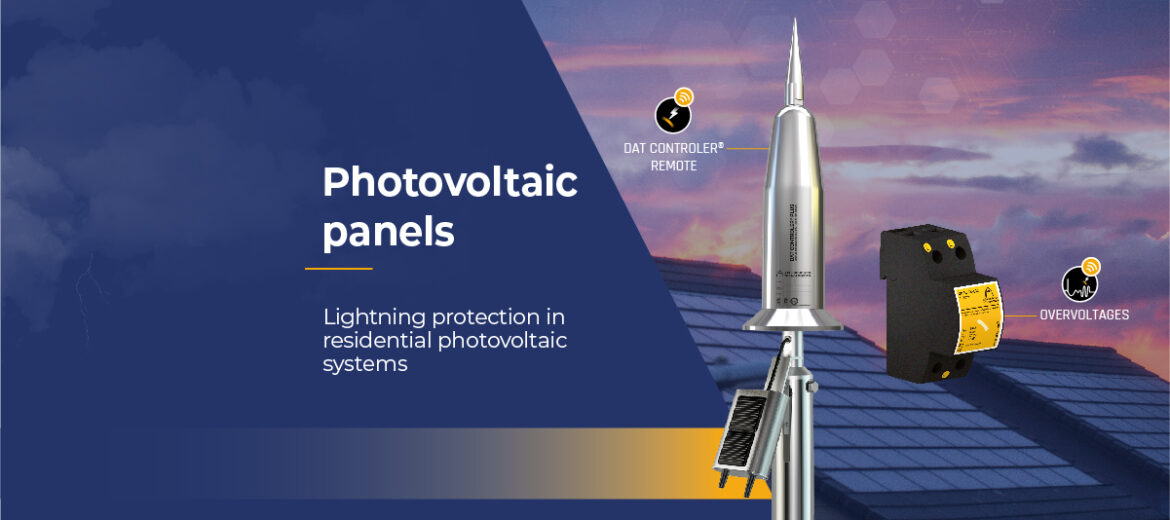Self-consumption of electricity by means of solar panels is arousing great interest among consumers both because of the savings in energy consumption, as they are less dependent on the external electricity grid, and because of the reduction in environmental impact. The high cost of installing solar panels in private homes, given that they take several years to pay for themselves, makes it essential that they are protected against the destructive effects of a lightning strike.
A solar self-consumption system allows any person or group of users, such as homeowners’ associations, to produce their own energy in order to depend as little as possible on external sources. In addition to the long-term savings in electricity consumption, by self-sufficiently generating part of the electricity consumed in a home, the installation of photovoltaic panels in residential environments allows the generation of cleaner environments by adopting a renewable energy production system.
A residential PV system can be of two types, depending on its installation and operation: on-grid and off-grid PV systems. Regarding the growth trend of residential solar panels, studies suggest that building-integrated PV could reach 8,300 TWh per year by 20501, 1.5 percent more than global residential electricity demand in 2015.
For either type of system, residential solar panels are mostly located on the roof of the building they power. Solar panels located at height are surfaces with a high risk of discharges and therefore require specific protection.
The amortisation of such an installation can take several years, so they must be protected to ensure a long and trouble-free service life. This is high-cost equipment which, when damaged, causes damage not only to the power supply but also to the panel itself and the connected equipment.
The operation of residential solar panels depends on sensitive electronic equipment which can be strongly affected by voltage surges causing degradation or deterioration of their components. They are therefore high-risk installations from a lightning protection point of view and must be provided with a suitable protection system.
External protection
The installation of an external lightning protection system has the mission of avoiding direct impacts on the structure, and therefore in this case on the photovoltaic panels installed on its roof.
An Early Streamer Emission (ESE) lightning arrester is an advanced lightning protection system that responds to the approach of lightning, anticipating the capture of other elements within its protection zone, in order to conduct it safely to the ground.
An ESE can protect a surface area of 20,000 square metres, which is considered level 1 protection, the most demanding, sufficient to protect a single-family home or a building in which photovoltaic panels have been installed for self-consumption of electricity.
Aplicaciones Tecnológicas has developed the DAT CONTROLER® REMOTE smart lightning conductor. Belonging to the Smart Earthing and Lightning Solutions range, it is a device with self-diagnosis of the head and communication via IoT (Internet of Things) of the result, to supervise the correct operation of the equipment remotely.
The installation of the DAT CONTROLER® REMOTE lightning conductor must be carried out in accordance with the UNE 21186 standard: “Lightning protection: Lightning arresters with Early Streamer Emission device”. In addition, care must be taken during installation to ensure that the lightning conductor does not cast shadows that could impair the efficiency of the solar panels.
Surge protection
The proper functioning of solar panels depends on sensitive electronic equipment, which can be severely affected by voltage surges resulting from lightning strikes or even lightning strikes close to the installation or in clouds.
Surge protection in residential photovoltaic installations must be designed to provide maximum protection for the photovoltaic cells and all elements that may be integrated.
For this purpose, a specific protector must be installed for the panels, which are usually not higher than 48V. Within its range of transient surge protectors for special equipment, Aplicaciones Tecnológicas has the ATVOLT P48, the surge protector for lines with a 48V DC power supply.
While in normal conditions, the ATVOLT P48 remains inactive, without affecting the operation of the line or producing leakage. The discharge occurs in encapsulated internal elements, without producing flashover and, thanks to its conductor connection by means of screws, it absorbs a higher overvoltage.
In addition to the possible degradation of solar panel components, an atmospheric discharge in a residential environment puts all other electrical and electronic equipment in a home at risk if it does not have an adequate surge protection system, including power line protection (KIT ATCONTROL/B PT-T and ATSUB-D M 1DIN), telephone line protection (AT9101 ATFONO), TV antenna line protection (ATFREQ SERIES) and data line protection (AT2107 ATLAN UNI RJ-RJ).
If you want to know more about how to protect any structure against the effects of lightning, you can contact us in this link.
You can also attend any of our webinars on external lightning protection at the following link.
References
